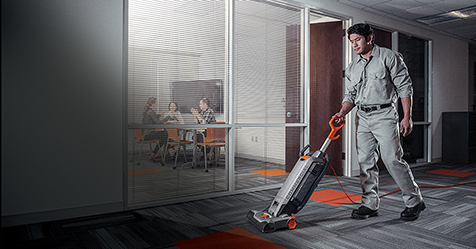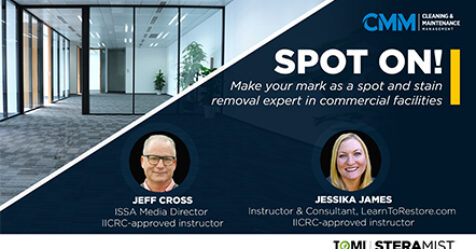Most hotels have a policy requiring that guest room mattresses be turned quarterly and flipped twice a year.
This helps increase their longevity and makes them more comfortable over time.
It’s too bad we can’t do the same when it comes to carpeting.
For, if we could, traffic lane soiling would likely become a thing of the past.
Traffic lane soiling frequently occurs in carpeted hallways, but it is equally common in large carpeted areas that are heavily traveled.
And, we all know how unattractive it can look.
The edges or less traveled areas of the carpet may look not just clean but brand new, yet the center areas that get all the foot traffic are dark, soiled and unsightly.
The cause of this issue is not only that these areas get pounded by hundreds — if not thousands — of shoes every day; the real problem is what’s on those shoes.
During the course of the day, grease, dust, dirt, sand, “gray” moisture and scores of other contaminants collect on the bottoms of shoes.
As people walk over traffic lanes, these soils get ground into the carpet fibers.
Although carpeting is designed to trap and hide much of this soiling, it reaches a saturation point at which it can no longer hide the damage.
Fortunately, there are ways to clean carpets affected by traffic lane soiling and, possibly even more important, ways to prevent it.
One involves using proper carpet cleaning methods and the other pertains to the proper placement of high-performance matting systems.
Cleaning Traffic Lane Carpets
Cleaning professionals have a variety of carpet cleaning methods at their disposal: Dry, shampoo, bonnet, extraction, encapsulation and others.
Although many can be effective at removing traffic lane soiling, some are more effective over the long term than others.
Two common methods of removing traffic lane soiling are shampooing and bonnet cleaning, both of which use a rotating buffer to clean the top surface of the carpet.
Often, the cleaning chemicals contain a “brightener,” which helps improve the appearance of the carpet, especially right after treatment.
However, these two methods, which are often referred to as interim carpet cleaning methods, have some serious drawbacks when it comes to removing traffic lane soils:
- First, they typically clean just the top fibers of the carpet; the deeply embedded soiling is not touched
- Second, the chemicals used in the shampoo/bonnet cleaning process can leave a chemical residue in the carpets, acting like a magnet and drawing more soils to it — referred to as resoiling
- Third, they can actually spread soils during the cleaning process in the traffic lanes instead of removing them.
Although these two methods can still be used, the key thing to realize is that they are interim steps that essentially keep the carpet “evenly dirty” by “feathering” dirty traffic lanes into the surrounding cleaner areas so they aren’t as noticeable.
When carpet traffic lanes must be cleaned quickly and drying time is an issue, these methods can be effective.
However, the traffic lanes eventually need a much more thorough cleaning, and this is when the “big guns,” carpet extractors, are required.
The Big Guns
Carpet extractors inject water and solution into the carpet in one forward pass and then extract the solution along with soils and contaminants by pulling back on the wand.
Typically, to treat pathway soiling, as many as three passes are required.
According to Doug Berjer, product manager for CFR Corporation, manufacturers of recycling extractors, key to the extractor cleaning process in all carpet cleaning, but especially with traffic lane soiling, are three things:
- Pounds of pressure per square inch (PSI) of the machine
- Effective moisture removal
- Heat.
“A portable extractor for effectively cleaning traffic lanes should have 500 PSI or more,” says Berjer. “This provides the pressure and power necessary to reach deep into carpet fibers, removing the soiling that is causing the darkened traffic lanes.”
As to moisture removal, along with the vacuuming power of the machine, the wand plays a crucial role.
Wand technology has advanced considerably in recent years.
Some systems, Berjer says, “atomize” the cleaning process, ensuring that moisture never rests on the carpet surface or backing.
The process more effectively removes moisture and cleaning solution — and carpets dry faster.
“This is also important because, if the traffic lanes are walked on before the carpets are dry, they are more vulnerable to resoiling,” Berjer adds.
Finally, extractors that heat the cleaning solution can also prove to be more effective at traffic lane soil removal.
Berjer points to author and cleaning expert Dr. Michael Berry, who writes that many contaminants can be removed “even without soap” because the hot water dissolves them.
However, Berjer recommends prespraying traffic lanes with an effective cleaning agent before extraction.
Prevention
Now that we understand what traffic lane soiling is and how to remove it, we can discuss how to prevent it.
According to Christopher Tricozzi, vice president of sales and marketing for Crown Mats and Matting, one of the leading and oldest matting companies in North America, “A high-performance matting system is designed to capture, trap and hold soils and moisture before they can be walked onto carpets and soil pathways.”
However, just placing a mat at the door will not do.
Tricozzi suggests as much as 15 feet of matting is necessary, including:
- Five feet of scraper mat placed outside the facility, which is designed to scrape off debris from shoe bottoms
- Five feet of wiper/scraper matting placed directly inside doors, which removes more debris and moisture
- Five feet of wiper matting placed directly after the wiper/scraper mat, which removes any remaining debris and moisture from the shoes, completing the matting system.
“What is vital to understand about a high-performance matting system is that it requires three different types of mats, each five feet long, all working together,” adds Tricozzi. “This ‘systems’ approach is especially necessary in locations where pathway soiling is a problem.”
In years past, carpets in office areas were expected to last five to seven years, while hallway carpets would have to be replaced every two to three years.
Now, we know there are effective ways to both remove traffic lane soils and help prevent them.
This can be a major cost savings for end customers, which can earn the cleaning contractor that puts them into practice a hearty “job well-done” from their clients, in addition to their repeat business.



